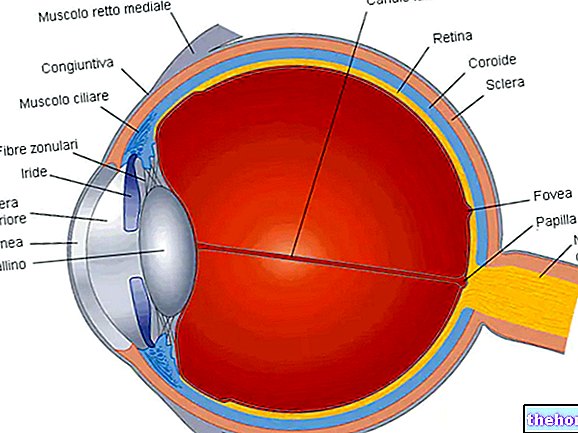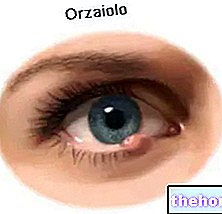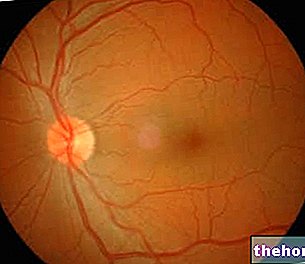So is the Aqueous Humor
The aqueous humor (or aqueous humor) is a colorless and transparent liquid contained in the anterior segment of the eye. It is formed by secretion from the ciliary body and is mainly made up of water, salts and protein substances. Cellular elements, on the other hand, are almost absent.
The aqueous humor acts as a refractive medium (optical function) and supplies nutrients to the cornea and lens (nutritional function). It also helps to maintain intraocular pressure (static function).

The chambers of the eye
The eyeball is a closed spheroidal anatomical structure, hollow inside.
Crystalline and ciliary body separate the eye into two fluid-filled cavities, one anterior and one posterior:
- The anterior cavity, smaller, can in turn be divided into two chambers (anterior: between the cornea and iris; posterior: bordering the lens and the ciliary body), both containing aqueous humor (liquid).
- The posterior cavity, on the other hand, occupies about four fifths of the entire eyeball; it extends from the posterior aspect of the lens to the retina and contains the vitreous, gelatinous and transparent body (for this reason, the posterior cavity is also called the vitreous chamber).
Both the vitreous body and the aqueous humor help stabilize the shape and position of the eye.
Characteristics and properties
The aqueous humor occupies the space included in the anterior cavity of the eyeball. Produced by the ciliary body, it consists mainly of water, in which protein substances and minimal quantities of salts are dissolved. In the aqueous humor, in particular, there are amino acids, chlorides, hyaluronic acid, glucose and ascorbic acid. In addition, very rare lymphocytes can be found, the number of which increases considerably during inflammatory processes of the eye. The pH is slightly alkaline (7.22).
Functions
The aqueous humor performs multiple functions:
- It participates in the refraction process, being one of the dioptric means of the eyeball;
- It helps to give consistency and volume to the eye and stabilizes the shape of the cornea, thanks to the pressure it exerts on the internal walls (ocular physiological tone);
- It performs a nutritional function towards the lens and the cornea (ocular structures without vessels);
- It has the task of keeping the lens intact and transparent;
- It avoids the cornea, the crystalline and the iris from strong changes in temperature;
- It plays a fundamental role in the regulation of intraocular pressure.
Dynamics of the aqueous humor
Aqueous humor is a liquid that continuously circulates inside the eye. In this way, it acts as a transporter of metabolites and waste substances.
The aqueous humor is produced by the secretory and filtering activity of the ciliary body (portion of the middle tunic or uvea of the eyeball, located behind the iris).
The flow of aqueous humor is made possible by the difference in pressure existing between the liquids inside the eye (which normally is around 14-20 millimeters of mercury) and that in the episcleral veins (about 9-13 mm Hg).
Production
The aqueous humor is formed as interstitial fluid, mainly from active secretion mechanisms: it passes through the epithelial cells of the ciliary processes and flows into the posterior chamber. From this it passes, passing the pupil, into the anterior chamber (space between the cornea and the " iris), where it is reabsorbed. A minor productive path occurs for the ultrafiltration of the plasma at the level of the capillaries of the ciliary body.
Reabsorption
Most of the reabsorption takes place in the anterior chamber, mainly at the edge of the iris. Urged by intraocular pressure, the aqueous humor passes through the progressively smaller pores that make up the trabecular network, located between the sclera and cornea, and enters the canal. Schlemm's (or venous sinus of the sclera). This last element constitutes an outflow path towards the venous circulation of the eye. Schlemm's canal communicates, in fact, with the episcleral veins. Resorption by this route therefore depends on the intraocular pressure gradient.
Aqueous humor and ocular tone
The rhythm of production and reabsorption of the aqueous humor is accomplished in such a way as to determine a pressure between 10 and 21 mmHg (normal range) inside the eye. To keep this value stable, the eyeball continuously produces a small amount of aqueous humor, while an equal level of this fluid is drained through a complex network of cells and tissues, located in the anterior chamber, near the ciliary body.
However, considering that the aqueous humor is a continuously renewed and circulating liquid, the intraocular pressure is not an immutable constant. An "excessive production of the aqueous humor" or an obstacle to its outflow can cause ocular hypertension, a condition that predisposes to the onset glaucoma (subtle eye disease that impairs visual function following a pain in the optic nerve). In addition, there are pathological changes characterized by hypotonia, due to a lower production of aqueous humor or excessive drainage.
Aqueous humor and glaucoma
In the "eye affected by glaucoma," an excessive production or an obstacle to the outflow of aqueous humor produces an increase in intraocular pressure. The resulting compression of the tissues inside the eyeball begins insidiously to alter the optic nerve and, in the time, causes the progressive reduction of vision and visual field.
Numerous other risk factors are associated with glaucoma: old age, familiarity with the disease, belonging to the African-American population, high myopia, reduced central corneal thickness and circulatory alterations, such as those induced by hypertension. previous ocular trauma and prolonged use of corticosteroids (eye drops, ointments or systemic drugs) can also contribute to causing or aggravating glaucoma.
Glaucoma is often called the "silent thief of sight", as in most cases the disease progresses unnoticed, without causing noticeable symptoms. The patient becomes aware of the disease only at an advanced stage, when the visual function is now irreversibly compromised.
The most frequent form of glaucoma, called simple chronic (open angle), occurs as a result of the progressive narrowing of the outflow pathways of the aqueous humor. Mostly, it is asymptomatic, but some signs may lead to suspicion of an increase in ocular tone: headache, rapid decrease in visual acuity, blurring and alterations of the visual field (eg halos around lights).
Acute (angle-closure) glaucoma, on the other hand, can occur suddenly with a pain around and inside the eyeball, so intense that it induces nausea and vomiting. This form is caused by a reduced "angle" between the iris. and the cornea ("lower anterior chamber").
There is also a form of congenital glaucoma, in which the drainage system, from birth, does not allow the regular outflow of the aqueous humor. The resulting increase in intraocular pressure causes the child to photophobia (discomfort in the light) and tearing.
The "asymptomatic" progression of the disease can be avoided with periodic visits to the ophthalmologist, which allow an effective and personalized therapeutic strategy to be set up early. Glaucoma is usually treated with the use of hypotonic eye drops to be instilled in the eye regularly and continuously. , to keep the pressure constant over 24 hours. If this approach proves insufficient, it is also possible to resort to laser intervention or surgical therapy, in order to restore the normal outflow of aqueous humor.




























